VOL. XXX, N umber two --------------------- WASHINGTON AUGUST, 1916
LITTLE-KNOWN SARDINIA
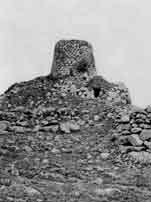
BY HELEN DUNSTAN WRIGHT
PHOTOGRAPH BY C.W.WRIGHT
THOSE who have taken the Mediterranean route have at least had a glimpse of Sardinia from their steamer a day out from Naples. The island is in sight for some hours, and, if the steamer passes sufficiently close, a bold rocky coast can be seen on which Roman outlook towers remain similar to those scattered along the south shores of Spain. The tourist seldom includes a trip to Sardinia in his travels, as neither of his advisers, Thomas Cook nor Baedeker, recommends it to him. It, however, is one of the few foreign fields that has not been overrun and overfed by the tourist, and in many of the villages a traveler is still regarded as a guest and not as prey to be pounced upon.
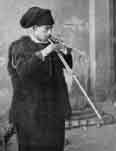
Some day, when tourists are tired of taking the tours laid out for them by the guide-books, perhaps they will break away from the continent and set sail for Sardinia, especially if they are not traveling just to enjoy hotel comforts. One can rent a good automobile at Cagliari, and a week spent touring around the island would probably leave the pleasantest of recollections and an experience long to be remembered.

Sardinia can
be reached by an eight hours' night voyage from Civitavecchia,
the port of Rome, to the north end of the island. The crossing
on the mail steamer is quite comfortable, but the knowledge that
one must get up at five the next morning is rather appalling.
The beauty of the sunrise over the sheer cliff's and
craggy isolated rocks "of Golfo degli
Aranci compensates, however, for this inconvenience and for the
cup of bitter black coffee which comprises the breakfast.
As soon as one lands, a refreshing fragrance in the air is noticed-a
perfume characteristic of Sardinia-not due, certainly, to orange
trees, as is suggested by the name of the port, there being none
in this district, but to the many wild herbs and shrubs all over
the island.

The first couple of hours' journey down the island is over a
rough, rolling country made up of granite and resembling parts
" of Arizona or Montana. This apparent waste land is used
for pasturing goats, which feed on the shrubs. PIere, as over
most of the island, one finds the white flowering cystus, bright
yellow ginestra, rosemary, a mass of blue when in blossom, and
pink heather; also arbutus with bright yellow and red berries,
thyme, juniper, and other shrubs.
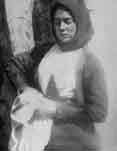
Excepting the eucalyptus and pine planted near the stations, there is a noticeable lack of trees along the railway routes. Among the mountains, however, which occupy the eastern half of the island and occur to some extent along the western coast, there are important forests of oak, ilex, cork, and wild olive; also areas reforested with pine and chestnut trees. In the mountainous areas of the island are many fertile valleys.

The scenery here compares favorably in grandeur with that of
many countries of tlie world. The finest scenery is among the
Gennargentu Mountains in the Barbargia Range, the highest peak
being 6,233 feet above sea-level; on it there is usually snow
from November to April. This region is called the Switzerland
of Sardinia. In the other ranges are many picturesque peaks,
as, for instance, Monte Albo, a group of limestone mountains
with practically no vegetation on their slopes; so that the white
mountains and the blue Mediterranean at their feet offer striking
contrasts.
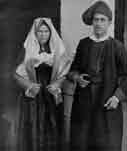
But, to return to the railway route, at Chilivani, one-third
of the way down the island, is the junction of the road that
goes west to Sassari, the capital of the northern province of
Sardinia. This city is situated in the midst of a well-cultivated
area, with groves of olive, almond, orange, and lemon trees and
orchards of apples, peaches, cherries, and other fruits. The
railway continues to the coast of Al-
ghero, an interesting old Spanish port, at one time surrounded
by a high fortified wall. It is here that Admiral von Tirpitz
owns a large agricultural farm and has a villa, and where, at
the beginning of the war, the Germans were suspected of having
a base for supplying submarines.
To the south, about half way down the island, at Macomer, is
another branch road to Nuoro, a distance of 35 miles and the
center of a mountainous district, the Barbargia, which was at
one time said to be the home of the famous Sardinian brigands.
These are practically "extinct" now, although occasionally
one hears of a man who has murdered a neighbor or a member of
his family for some personal wrong and, in order to escape the
carabinieri, or national police, flees to the mountains and lives
as best he can, sometimes stealing a lamb or a goat from a shepherd
or stopping a lonely traveler to ask for food or a few soldi.
Unfortunately, the general impression outside of Sardinia, even
in Italy, is that the island is more or less overrun by bandits;
this is not true, and a traveler on the island today is even
safer than he would be in southern Italy or Sicily.
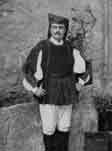
Macomer is the
center of the region where many fine horses are bred for the
army, as are also the small ponies used in Naples. After passing
this town, the railroad descends to Oristano, on the west coast,
noted for its pottery and particularly its delicious pastry and
almond sweets. The road then runs diagonally across a valley,
from 10 to 15 miles wide, which extends down to Cagliari, at
the southeastern end of the island.
Cagliari is the principal port of Sardinia, and is often visited
for a few hours by tourists taking the weekly steamer from Genoa
and Livorno to Tunis. The bay of Cagliari is most impressive.
On the right and left as you enter are hills, with mountains
in the distance, while rising up from the lowlands directly opposite
the entrance is the city, on a rocky hill 400 feet high. The
top of this hill is encircled by a massive wall, built by the
Pisans in the thirteenth century. At two of its angles rise the
towers of the Lion and the Elephant, but of the tower of the
Eagle, which completed the triangle, only the base remains. In
the center of these fortifications is the old town and the cathedral.
On the slopes of the hill outside the walls is built the modern
city.
Surrounding Cagliari are shallow bays, which extend inland for
many miles, and are of interest because of the government salt
recoveries, where huge mounds of salt, 20 to 40 feet high, can
be seen on the flats. In the spring flocks of flamingoes and
other birds congregate on these lowlands and add to the beauty
of the scenery. The land around the lagoons is especially fertile
and well cultivated with truck gardens and vineyards, from which
a very large quantity of wine is made.
Cagliari, the largest city on the island and the capital of the
southern province, has about 53,000 inhabitants. The entire population
of the island is estimated at 796,000, a density of population
of 85 per square mile; this is a much lower figure than in any
other part of Italy.
Among the objects historically interesting in Cagliari are rock-cut
tombs on the hillside below the Castello. These are probably
of the same period as the "nuraghi," the famous prehistoric
remains in Sardinia, and some may have been enlarged by the Romans
into the tombs which still exist, well preserved and with Latin
inscriptions on their walls.
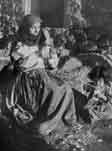
Of the Roman
period an ampitheater remains. This is on the side hill to the
west of the city and is fairly well preserved, with the passages
under the tiers of seats. The work of the Pisans in the cathedral
was begun in 1312 A. D. and finished by the Aragons in 1331,
but later partly rebuilt by the Spaniards in 1669. Among the
modern buildings is a beautiful city hall, recently completed;
a university with its library, which has a valuable collection
of manuscripts, among them a code of laws made by Eleanora of
Arborea, who was a ruler of a part of Sardinia when it was divided
into four provinces under the Spaniards. The southeastern corner
of the old fortifications has been remodeled to form a "piazza"
above the city. I-Iere concerts are held at midday on Sundays
during the winter months and on summer evenings. It is the fashionable
promenade, as is also the Via Roma, a boulevard along the edge
of the bay.
Throughout Sardinia prehistoric monuments are prominent in the
shape of truncated cones about 30 feet in diameter at the base
and built of large rough blocks of stone about 2 feet high and
of varying lengths. Tliese towers are the "nuraghi"
belonging to the Bronze Age and show that the island must have
been well populated in the centuries antedating the Christian
era. The entrance to the "nuraghi" usually faced the
south and served to light the circular room within, as did also
a door opening to a spiral staircase built in the walls and leading
to a chamber above the ground floor. Few of the "nuraghi"
have the roofing preserved entirely, so that we no longer see
them in their full height or original cone shape. Some have two
or three chambers on the ground floor with niches in the walls,
probably for household gods.
These towers were undoubtedly forti-
fied habitations. They are usually situated in commanding- positions
at the entrance to tablelands, near the fords of rivers, or on
almost inaccessible mountain peaks, and within signaling distance
of one another. Traces of at least 5,000 "nuraghi"
have been found.
The ancient tombs of the inhabitants of the "nuraghi"
are usually found near them. These are called the "tombs
of the giants," and are chambers y/2 feet wide and from
30 to 40 feet long, with a roof of flat slabs of rock and with
the sides made of the slabs or of rough walling. The bodies were
probably arranged in a sitting position. In front of the tombs
are circles about 40 feet in diameter, surrounded by stones;
these were, no doubt, used for sacrifices and burial rites.
Another type of tombs found in Sardinia is that of the small
grottoes cut in the rock like those in prehistoric cemeteries
in Sicily. In these tombs and in the "nuraghi" sarcophagi
were discov
ered, generally of marble; also idols consisting of small bronze
figures varying from 4 to 17 inches in height, images of dogs,
bats, apes, and other animals-all most crude in workmanship and
grotesque in form; medals, coins, vases, ornaments, arms, and
articles of ten-a-cotta and glass. Most of these latter must
antedate the Roman occupation. Some of these relics and similar
objects, including articles of jewelry dating from the Roman
occupation, can be seen in the Museum at Cagliari.
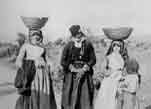
The Phoenician
settlement is the earliest of which there is any accurate knowledge.
Sardinia was said to be the grain-producing center of the Carthaginians
about 500 B. C. The Romans captured it in 238 B. C., and it was
then noted for its supply of corn. The Romans built many towns
and roads, and remains of their monuments, temples, and sepulchers
are still preserved. The Byzantines captured Sardinia from the
Romans and held it until the tenth century, when the Saracens
took possession, and were in turn driven out by the Pisans. There
are traces of the influence of Pisa in the fine Romanesque churches
which are still well preserved. In some churches the late Gothic
architectural style shows Spanish influence, which came after
the surrender of the Pisans to Genoa, and then to James II of
Aragon. In 1708 Cagliari surrendered to the English, but in the
War of Spanish Succession the island came under the rule of Austria.
Finally, after more exchange, it was given to the Duke of Savoy,
who acquired with it the title of King_of Sardinia.
It is not strange that the language of the people should contain
elements of the languages of all the races which have occupied
the island. The dialects, of which there are five or six, are
a mixture of Latin, Spanish, and Italian, with a little Phoenician
and traces of other ancient tongues. In Alghero, on the west
coast, pure Catalan is spoken; in some villages almost pure Latin
; and in Carloforte, on the southwestern coast, the Genoese dia-
lect prevails. Italian, however, is now taught in the schools
to the children, while the men acquire it during their compulsory
military service.
To get an insight into the life of the inhabitants of this isolated
island, one should visit its villages. It is in the entire eastern
half, with its mountainous valleys and villages, where the real
Sards now live. Here one will find them good looking and in good
health, generous, hospitable, honorable, and quite poor. Politeness
is carried almost to an extreme. Often as one rides th rough
a small village the women, children, and old men sitting at the
doorsteps rise and wish you a "buon viaggio"; or if
it happens to be noon, some may wish you a "buon appe-tito."
Even the young boys are taught to take their hats oft" when
strang-ers pass by; and if one is in an automobile and happens
to stop to get out his kodak, a crowd of youngsters seem to spring
up around the car, all anxious to be in the picture. To refuse
a cup of coffee or a liqueur when visiting the house of an inhabitant
of a village is an act of great discourtesy, and even the poorest
have some beverage to offer.
Generally speaking, the peasants seem to be somewhat downtrodden
and do not realize their just rights. We thought the attitude
of the man in the following incident most unusual: When motoring
along one of the straight roads down through the valley to Cagliari,
we saw a man ahead on horseback. He jumped off in a great hurry
and, holding the horse by the end of the reins, got down into
the deep ditch at the side of the road. As the car came up he
was so interested in probably the first automobile he had ever
seen that he forgot his horse, which, unexpectedly, gave a jump
down into the ditch almost on top of the man, upsetting him and
his saddle-bags into the mud. When we stopped to examine the
harm done and to help him up he was very gratified and most profuse
in his apologies for having disturbed us, saying: "Excuse
me, excuse me; it was all my fault."
The music of the Sards is characteristic ; not all quick and
vivacious like that of the Sicilians or other southern Italians,
but monotonous and slow, resembling very much the music of northern
Africa. Often a long song will be sung to one phrase of a melody,
like a sorrowful chant. The accordion is a favorite instrument,
and in the villages on Sundays or other festas most of the inhabitants
congregate in the principal piazza and dance to its music. The
men and women form in a circle and dance slowly forward and backward,
some of the younger men adding more complicated steps, occasionally
breaking away from the circle and dancing with their partners
; but the whole effect is dignified and staid.
Each "paese" or village has its annual
festival to celebrate the birthday of its own particular saint
or some other church feast. The most renowned of these is the
"testa" of "Saint' Efisio," the national
feast of the island. The ceremony is in the form of a procession
from Cagliari to Pula, a village 9 miles away, with the return
to Cagliari. The saint was an official in the army of Diocletian,
and for his conversion to Christianity was beheaded at Pula.
On midday of May i the procession leaves and returns on the evening
of May 4. It is composed of a cavalcade of horsemen all in the
costume of the ancient Sardinian militia, escorting the image
of the saint, which is preceded by musicians playing the "launeddas,"'
an instrument made of three or four reeds of different lengths
and like the pipe of ancient times.
In the region about Iglesias where the mines are, the workmen
celebrate annually the festa of Santa Barbara, "the god
of fire," which usually results in much wine drinking, followed
by a few days' absence from work, so as to recuperate.
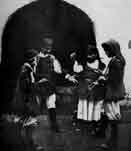
The Sards' costumes
are one of their
greatest attractions. They are of rich, harmonious, though brilliant,
colors, each village having its own distinctive type, which does
not change from year to year;
so the men and women are thus known by the clothes they \vea.r.
Unfortunately the general European type of dress is being adopted
by the younger generation, and it is now difficult to find many
towns in which the native dress is used by all the inhabitants.
There are a few such villages up in the mountains near Nuoro,
where the railroad has not penetrated, and here it is most interesting
to see the women and little girls all dressed alike. The skirts
are usually very full, accordion plaited in some villages,with
a distinctive trimming;
white waists with full sleeves, and over these short jackets,
open in front or laced around the waist. All in a town have the
same combination of color, perhaps a dark red skirt and the jacket
in bright red and bright blue, a diagonal stripe of each
color meeting in the back, and with tiny bonnets of the two bright
colors. In some the most distinctive characteristic is the covering
of the head-a bright-colored handkerchief or a white veil folded
back or held in place by a silver chain under the chin; in other
towns the apron is characteristic in its color and shape.
The most elaborate dresses are, of course, kept for festas, and
these have hand embroidery and are often of very heavy silks
and brocades, sometimes with exquisite lace scarfs or veils folded
back on the head. The jewelry is most elaborate, too-large gold
buttons worn at the throat; large ear-rings and pendants. The
costumes and jewelry are almost always heirlooms in the families.
The men's costumes usually consist of woolen leggings, white,
full trousers, long or short, a full ruffle of black cloth worn
around the waist; and this, too. differs in length. Some of the
jackets are short and some long, but all have silver buttons
down the front. The shepherd wears a sheepskin, on which the
wool has been left, over his shoulders throughout the year, even
in midsummer, and claims that it keeps away the malaria. In some
districts the men wear a pointed cap resembling- a Phrygian bonnet,
long and narrow like a stocking, reaching almost to the waist;
the point is either worn down over the shoulders or folded on
the top of the head and may be used as a pillow at night. It
is apt to contain anything from bread to snuff, which is indispensable
to the older Sard. A queer custom of some of the younger men
is to let the hair on the top of their heads grow often to 15
inches in length, and then roll it up into a puff, which looks
like a pompadour, across the forehead.
Among the distinctive products of Sardinia is cheese made of
goat's milk and used very generally by Italians. The wines are
noted for their strength. An interesting export is cork, which
is taken from the trees every five years, leaving the bare, red
trunks noticeable all over the island. Many sheep, goats, pigs,
cattle, and horses are raised and sold on the continent.

The mining industry
is probably the most important, the principal metals produced
being lead and zinc. Iglesias, in the southwestern corner, is
the center of mining activity. The mines employ about 15,000
workmen, and the output is
approximately 60,000 tons of lead concentrates and 120,000 tons
of zinc concentrates annually. Some silver, iron, antimony, copper,
and coal are also produced.
The tunny fisheries off the island of San Pietro are noteworthy.
In.the spring schools of these 'fish pass through the Mediterranean,
and enormous numbers are caught in nets and .brought to the large
canneries at Carloforte.
There is very good "hunting on the island. The moufflon,
a cross between a wild sheep and a deer, is found in the mountains
and is native only to Sardinia;
there are also some fallow deer and red deer. By far the most
numerous of the big game is the wild boar. Hare, partridges,
woodcock, snipe, quail, and w^ild duck are all found in large
quantities.
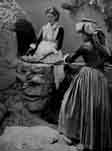
The wild flowers
are most beautiful, and there is practically no month in which
a great variety is not found. Among these are orchids, narcissus,
lilies, gladi-olas, irises, cyclamen, fox-gloves, poppies, and
sweet peas. In the summer months, usually from May until September,
there is no rainfall. During the winter the rains are heavy and
often accompanied by strong winds. In the northern part of the
island a good deal of snow falls, and often the ground remains
covered for a month at a time; but in the southern part of the
island there is almost never any snow and seldom any frost. In
the gardens there roses, heliotrope, calla lilies, nasturtiums,
ivy, geraniums, marguerites, and many other flowers bloom all
winter. It is during the summer that these cease blossoming.
May, June, and October are the months most pleasant for travel
in Sardinia. The country is at its best then; the cultivated
fields green, the wild flowers most profuse, the climate least
variable, and the roads, which are covered with "ghiaia,"
or broken rock, from December to February, are then in perfect
condition.
| HOME |
| AUTORI |
| BIBLIOGRAFIA |
| LIBRI |
| LINKS |
| MOSTRE |
| STORIA |
| GUESTBOOK |
|
|
|||||||
|
il logo MUFO è un marchio registrato del Museodellafotografia - Design: Dracmes |
|||||||